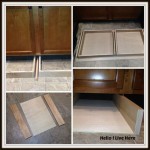How To Revarnish Kitchen Cabinets: A Comprehensive Guide
Kitchen cabinets, subjected to daily use and exposure to moisture, grease, and temperature fluctuations, inevitably show signs of wear and tear over time. Revarnishing can restore their aesthetic appeal and extend their lifespan, offering a cost-effective alternative to complete replacement. This process involves careful preparation, application, and finishing techniques to achieve a professional-looking result.
Before embarking on the revarnishing project, it's crucial to assess the existing finish and identify any underlying issues. The existing varnish might be peeling, cracked, or simply dull. Addressing these problems is essential for ensuring the new varnish adheres properly and provides a durable and attractive surface. This guide provides a detailed walkthrough of the revarnishing process, covering material selection, surface preparation, varnish application, and post-application care.
Key Point 1: Preparation and Assessment of Existing Cabinets
The success of revarnishing hinges on thorough preparation. This stage involves several crucial steps, starting with a detailed inspection of the existing cabinets. Every door, drawer front, and cabinet frame must be examined for damage, including chips, scratches, dents, and staining. Any repairs needed must be addressed before proceeding with the actual varnishing.
The initial stage involves removing all hardware, including knobs, pulls, hinges, and any other attached decorative elements. This prevents them from being coated with varnish and ensures a clean, professional finish. It is recommended to store the hardware in labeled containers to simplify reassembly. Take photos before disassembly, these can serve as a useful reference during reinstallation, especially if the hardware arrangement is complex.
Cleaning the cabinets is essential to remove any surface contaminants, particularly grease and grime common in kitchen environments. A degreasing cleaner, specifically designed for wood surfaces, is recommended. Apply the cleaner according to the manufacturer's instructions, using a soft cloth or sponge to gently scrub the surfaces. Rinse thoroughly with clean water and allow the cabinets to dry completely before proceeding further.
Once the cabinets are clean and dry, assess the condition of the existing varnish. If the varnish is heavily damaged, peeling, or cracking, it must be removed entirely. This can be achieved through chemical stripping or sanding. Chemical strippers are effective in removing old varnish, but they require careful handling and proper ventilation. Sanding is a more labor-intensive option, but it provides greater control over the removal process. When sanding, start with a coarser grit sandpaper (e.g., 80-grit) to remove the bulk of the varnish, then gradually move to finer grits (e.g., 120-grit, 220-grit) to smooth the surface and prepare it for varnishing.
If the existing varnish is in relatively good condition, with only minor scratches or dullness, it may be sufficient to scuff sand the surface. This involves lightly sanding the varnish with fine-grit sandpaper (e.g., 220-grit or 320-grit) to create a slightly rough surface that will allow the new varnish to adhere properly. After sanding, thoroughly remove all dust with a tack cloth or a vacuum cleaner with a soft brush attachment. The surface must be completely clean and free of dust before applying the new varnish.
Addressing any repairs before varnishing is critical. Fill any holes or imperfections with wood filler, allow it to dry completely, and then sand it smooth to blend with the surrounding surface. Clean the repaired areas thoroughly before varnishing. Evaluate for the presence of mold or mildew, if present, these should be eliminated using a mold and mildew cleaner, followed by thorough rinsing and drying.
Key Point 2: Selecting the Right Varnish and Application Techniques
Choosing the appropriate varnish is crucial for achieving the desired aesthetic and protective qualities. Several types of varnish are available, each with its own characteristics and suitability for different applications. Oil-based varnishes are known for their durability and resistance to moisture and chemicals. They provide a warm, amber-toned finish that enhances the natural grain of the wood. However, oil-based varnishes typically dry slower and emit stronger odors compared to water-based options.
Water-based varnishes offer several advantages, including faster drying times, lower odor, and easier cleanup. They are also more environmentally friendly than oil-based varnishes. Water-based varnishes provide a clear, non-yellowing finish that allows the natural color of the wood to shine through. Polyurethane varnishes are a type of synthetic varnish that offers excellent durability and resistance to abrasion, scratches, and chemicals. They are available in both oil-based and water-based formulations. Polyurethane varnishes are a good choice for high-traffic areas that are subject to frequent wear and tear.
Application techniques play a significant role in the final appearance and durability of the varnished surface. The ideal application method depends on the type of varnish, the size and complexity of the cabinets, and personal preference. Brushing is a traditional method that allows for precise application in detailed areas. Use a high-quality brush with natural or synthetic bristles, depending on the type of varnish. Apply the varnish in thin, even coats, following the direction of the wood grain. Avoid excessive brushing, as this can create brush marks and bubbles.
Spraying offers a faster and more efficient way to apply varnish, especially on large or intricate surfaces. A spray gun provides a uniform coating and minimizes brush marks. However, spraying requires careful preparation and proper ventilation. Mask off surrounding areas to protect them from overspray, and use a respirator to avoid inhaling varnish fumes. Apply the varnish in thin, even coats, overlapping each pass slightly.
Regardless of the application method, it is crucial to apply multiple thin coats of varnish rather than one thick coat. Thin coats dry more evenly and reduce the risk of runs, drips, and bubbles. Allow each coat to dry completely according to the manufacturer's instructions before applying the next coat. Between coats, lightly sand the surface with fine-grit sandpaper (e.g., 320-grit or 400-grit) to remove any imperfections and create a smooth, even surface for the next coat of varnish.
Proper ventilation is crucial during the varnishing process, especially when using oil-based varnishes. Ensure adequate airflow by opening windows and doors or using a ventilation fan. Wear appropriate personal protective equipment, including a respirator, gloves, and eye protection, to protect yourself from varnish fumes and potential splashes. Read and follow the manufacturer's instructions for the specific varnish being used, regarding safety precautions, application techniques, and drying times.
Key Point 3: Finishing and Post-Application Care
The finishing touches are critical for achieving a professional, long-lasting varnish finish. After the final coat of varnish has dried completely, inspect the surface for any imperfections, such as runs, drips, or dust particles. Remove any imperfections by lightly sanding with fine-grit sandpaper (e.g., 400-grit or 600-grit). Then, polish the surface with a rubbing compound or polishing compound to enhance the sheen and create a smooth, uniform appearance.
Reattaching the hardware is the final step in the revarnishing process. Carefully reattach the knobs, pulls, hinges, and other hardware that were removed during preparation. Ensure that the hardware is properly aligned and securely fastened. Use the photos taken during disassembly as a reference to ensure that the hardware is reinstalled in the correct locations. Clean the hardware before reattaching it to remove any dust or fingerprints.
Allow the varnished cabinets to cure completely before exposing them to heavy use or cleaning. Curing typically takes several days or even weeks, depending on the type of varnish and the environmental conditions. Avoid placing heavy objects on the cabinets or exposing them to excessive moisture during the curing period. Regular cleaning and maintenance will help prolong the life of the varnish finish. Use a mild soap and water solution to clean the cabinets, and avoid using abrasive cleaners or harsh chemicals that can damage the varnish.
Periodically inspect the varnish for any signs of wear and tear, such as scratches, chips, or dullness. Touch up any damaged areas with a small amount of varnish, following the same application techniques used during the initial varnishing process. Apply a coat of furniture polish or wax to the varnished cabinets to protect the finish and enhance the sheen. Follow the manufacturer's instructions for the specific polish or wax being used.
Proper waste disposal is essential for environmental safety. Dispose of used varnish cans, brushes, and rags according to local regulations. Allow oil-based varnish-soaked rags to dry completely outdoors before disposing of them to prevent spontaneous combustion. Store leftover varnish in a tightly sealed container in a cool, dry place. Properly stored varnish can be used for future touch-ups or other projects.
By meticulously following these steps, individuals can successfully revive their kitchen cabinets, augmenting both the aesthetics and longevity of their kitchen space. The rejuvenated cabinetry provides a visual upgrade and adds value to the home. Proper preparation, material selection, application techniques, and post-application care together guarantee a professional-looking result that homeowners can enjoy for years to come.

How To Re Varnish Cabinets Dans Le Lakehouse

How To Re Varnish Cabinets Dans Le Lakehouse Refinishing Wood Kitchen Refacing

How To Refinish Kitchen Cabinets N Hance

How To Refinish Kitchen Cabinets Diy

How To Re Cabinets Bob Vila S Blogs

Refinish Kitchen Cabinets Without Stripping

How To Re Worn Kitchen Cabinets Without A Complete Overhaul The Seattle Times

Staining Your Wood Cabinets Darker Young House Love

Refinish Kitchen Cabinets With Kilz Restoration Primer

How To Refinish Kitchen Cabinets Without Stripping Ron Hazelton
Related Posts








